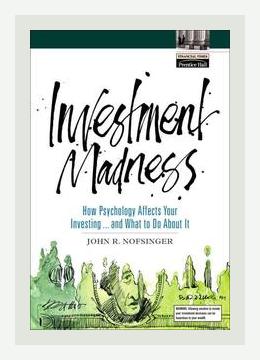Finance, Economics, Trading, InvestingBehavioral Finance
Introduction
“Investment Madness: How Psychology Affects Your Investing…And What to Do About It” by John R. Nofsinger delves into the often-overlooked psychological factors that influence investment decisions. Nofsinger, a leading expert in behavioral finance, presents a compelling exploration of how emotions, cognitive biases, and irrational behaviors can lead to poor investment choices. The book offers practical strategies to counteract these psychological pitfalls, making it a must-read for anyone looking to improve their financial decision-making. With the rise of behavioral economics, this book provides timely insights into the psychological traps that investors frequently fall into, and how to avoid them.
The Psychology of Investing: An Overview
Nofsinger begins by setting the stage with an introduction to behavioral finance, a field that examines how psychological influences and biases affect financial decisions. He argues that traditional economic theories, which assume that individuals always act rationally, fail to account for the emotional and cognitive factors that lead to irrational behavior. This section lays the groundwork for understanding why investors often make decisions that are not in their best interest.
Memorable Quote:
“The biggest enemy of the investor is likely to be himself.”
This quote encapsulates the central thesis of the book, emphasizing that self-awareness is crucial in avoiding common investment mistakes.
Cognitive Biases and Their Impact
In this section, Nofsinger explores various cognitive biases that distort investors’ perceptions and decisions. He discusses common biases such as overconfidence, where investors believe they have superior knowledge or abilities, leading them to take unnecessary risks. Another key bias is the confirmation bias, where investors seek out information that supports their existing beliefs while ignoring contradictory evidence.
Example 1: The Overconfidence Bias
Nofsinger shares the story of a seasoned investor who, convinced of his stock-picking prowess, continues to invest heavily in a declining company. Despite clear signs of trouble, his overconfidence blinds him to the risks, resulting in significant financial loss. This anecdote illustrates how overconfidence can lead to disaster.
Memorable Quote:
“Overconfidence is the mother of all biases; it leads us to overestimate our abilities, underestimate risks, and believe that we can control the uncontrollable.”
This quote highlights the pervasive nature of overconfidence and its detrimental effects on investment outcomes.
Emotional Influences on Investment Decisions
Nofsinger dives into the emotional aspects of investing, explaining how fear, greed, and regret can lead to irrational decisions. He argues that emotions often override logical thinking, causing investors to make impulsive decisions that can harm their portfolios. For instance, the fear of losing money can lead to panic selling during market downturns, while greed can drive investors to chase after high-risk, high-reward opportunities without fully understanding the risks.
Example 2: The Panic Sell-Off
The book recounts the 2008 financial crisis, where widespread fear led to massive sell-offs in the stock market. Investors, driven by panic, sold their holdings at rock-bottom prices, only to miss the subsequent market recovery. This example illustrates how fear can lead to poor decision-making and missed opportunities.
Memorable Quote:
“The market is driven by two emotions: fear and greed. When one dominates, the other is lurking just around the corner.”
This quote succinctly captures the emotional tug-of-war that often dictates market movements and investor behavior.
The Role of Herd Behavior
Herd behavior, where individuals follow the actions of a larger group, is another psychological factor that Nofsinger examines in detail. He explains how the fear of missing out (FOMO) can lead investors to follow the crowd, even when it goes against their better judgment. This behavior is often observed during market bubbles, where prices are driven up by speculative buying, only to crash when the bubble bursts.
Example 3: The Dot-Com Bubble
Nofsinger discusses the dot-com bubble of the late 1990s, where investors, caught up in the hype of the internet revolution, poured money into technology stocks. As more people joined the frenzy, stock prices soared to unsustainable levels. When the bubble finally burst, many investors suffered substantial losses. This example illustrates the dangers of herd behavior and the importance of independent thinking in investing.
Strategies to Counteract Psychological Biases
Having identified the various psychological traps that investors fall into, Nofsinger offers practical strategies to counteract these biases. He emphasizes the importance of self-awareness, discipline, and a long-term perspective in overcoming emotional and cognitive biases. Nofsinger also advocates for the use of systematic investment approaches, such as dollar-cost averaging, to mitigate the impact of emotions on investment decisions.
Practical Tips:
- Self-Awareness: Regularly assess your emotional state and recognize when emotions might be clouding your judgment.
- Discipline: Stick to a well-defined investment strategy, even when market conditions are volatile.
- Long-Term Perspective: Focus on long-term goals rather than short-term market fluctuations to avoid impulsive decisions.
The Importance of Continuous Learning
Nofsinger concludes by stressing the importance of continuous learning and adaptability in the world of investing. He argues that while psychological biases are inherent, they can be managed through education and experience. By staying informed and open to new ideas, investors can better navigate the complexities of the financial markets and make more informed decisions.
Conclusion: The Relevance of “Investment Madness” Today
“Investment Madness: How Psychology Affects Your Investing…And What to Do About It” remains highly relevant in today’s market environment, where psychological factors continue to play a significant role in investor behavior. With the rise of behavioral finance, Nofsinger’s insights offer valuable lessons for both novice and experienced investors alike. By understanding and addressing the psychological biases that influence decision-making, investors can improve their chances of achieving long-term financial success.
In summary, John R. Nofsinger’s “Investment Madness” is a comprehensive guide to the psychological pitfalls that can derail even the most seasoned investors. Through a combination of theoretical insights and practical examples, Nofsinger equips readers with the tools they need to recognize and overcome these biases. As the financial markets continue to evolve, the lessons in this book are as applicable today as they were when it was first published.
